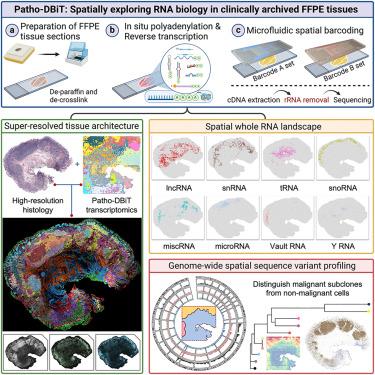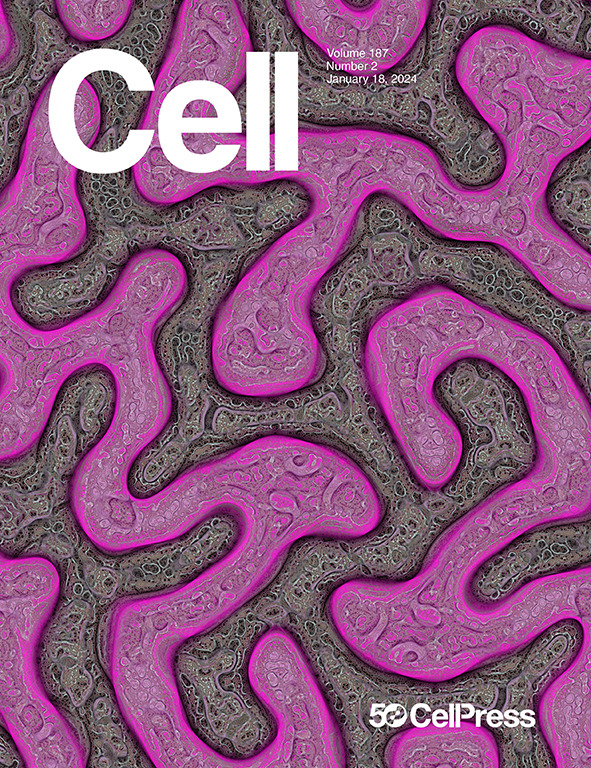Spatially exploring RNA biology in archival formalin-fixed paraffin-embedded tissues
IF 45.5
1区 生物学
Q1 BIOCHEMISTRY & MOLECULAR BIOLOGY
引用次数: 0
Abstract
The capability to spatially explore RNA biology in formalin-fixed paraffin-embedded (FFPE) tissues holds transformative potential for histopathology research. Here, we present pathology-compatible deterministic barcoding in tissue (Patho-DBiT) by combining in situ polyadenylation and computational innovation for spatial whole transcriptome sequencing, tailored to probe the diverse RNA species in clinically archived FFPE samples. It permits spatial co-profiling of gene expression and RNA processing, unveiling region-specific splicing isoforms, and high-sensitivity transcriptomic mapping of clinical tumor FFPE tissues stored for 5 years. Furthermore, genome-wide single-nucleotide RNA variants can be captured to distinguish malignant subclones from non-malignant cells in human lymphomas. Patho-DBiT also maps microRNA regulatory networks and RNA splicing dynamics, decoding their roles in spatial tumorigenesis. Single-cell level Patho-DBiT dissects the spatiotemporal cellular dynamics driving tumor clonal architecture and progression. Patho-DBiT stands poised as a valuable platform to unravel rich RNA biology in FFPE tissues to aid in clinical pathology evaluation.

档案福尔马林固定石蜡包埋组织中的 RNA 生物学空间探索
对福尔马林固定石蜡包埋(FFPE)组织中的 RNA 生物学进行空间探索的能力为组织病理学研究带来了变革性的潜力。在这里,我们介绍了病理学兼容的组织确定性条形码(Patho-DBiT),它结合了原位多聚腺苷酸化和空间全转录组测序的计算创新,专为探究临床存档 FFPE 样品中的多种 RNA 而定制。它允许对基因表达和 RNA 处理进行空间协同分析,揭示区域特异性剪接异构体,并对保存 5 年的临床肿瘤 FFPE 组织进行高灵敏度转录组图谱绘制。此外,还能捕获全基因组单核苷酸 RNA 变异,以区分人类淋巴瘤中的恶性亚克隆和非恶性细胞。Patho-DBiT 还能绘制 microRNA 调控网络和 RNA 剪接动态图,解码它们在空间肿瘤发生中的作用。单细胞水平的 Patho-DBiT 剖析了驱动肿瘤克隆结构和进展的时空细胞动力学。Patho-DBiT 是一个宝贵的平台,可以揭示 FFPE 组织中丰富的 RNA 生物学特性,帮助临床病理学评估。
本文章由计算机程序翻译,如有差异,请以英文原文为准。
求助全文
约1分钟内获得全文
求助全文
来源期刊

Cell
生物-生化与分子生物学
CiteScore
110.00
自引率
0.80%
发文量
396
审稿时长
2 months
期刊介绍:
Cells is an international, peer-reviewed, open access journal that focuses on cell biology, molecular biology, and biophysics. It is affiliated with several societies, including the Spanish Society for Biochemistry and Molecular Biology (SEBBM), Nordic Autophagy Society (NAS), Spanish Society of Hematology and Hemotherapy (SEHH), and Society for Regenerative Medicine (Russian Federation) (RPO).
The journal publishes research findings of significant importance in various areas of experimental biology, such as cell biology, molecular biology, neuroscience, immunology, virology, microbiology, cancer, human genetics, systems biology, signaling, and disease mechanisms and therapeutics. The primary criterion for considering papers is whether the results contribute to significant conceptual advances or raise thought-provoking questions and hypotheses related to interesting and important biological inquiries.
In addition to primary research articles presented in four formats, Cells also features review and opinion articles in its "leading edge" section, discussing recent research advancements and topics of interest to its wide readership.
 求助内容:
求助内容: 应助结果提醒方式:
应助结果提醒方式:


